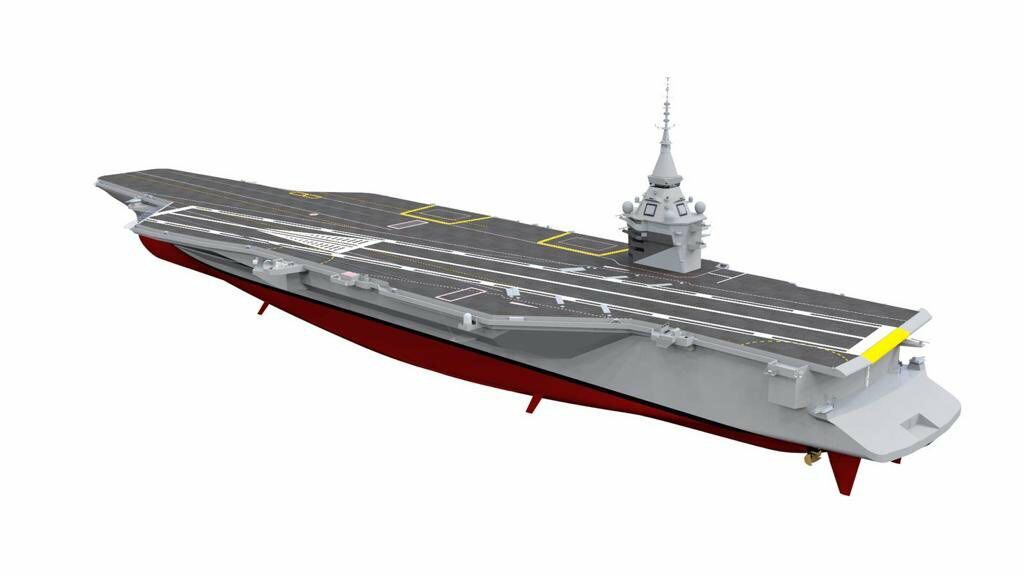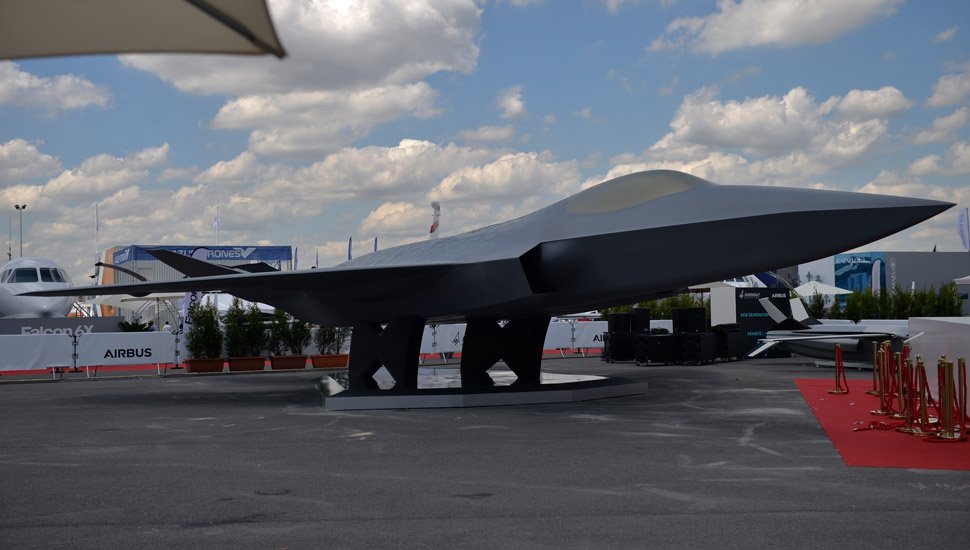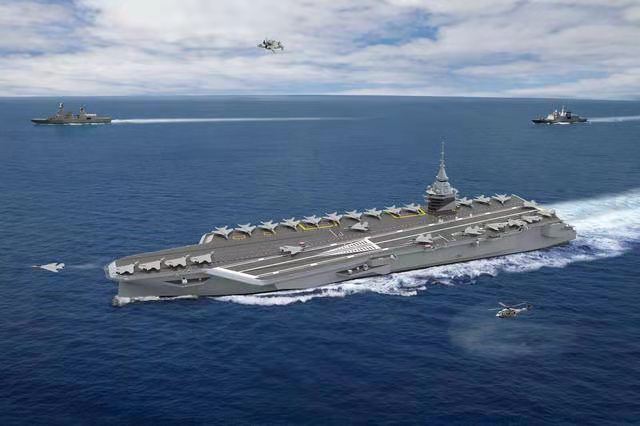Recently, French President Macron announced that the next generation of aircraft carriers in the country will adopt nuclear propulsion and will enter service in 2038 to replace the aircraft carrier Charles de Gaulle, which entered service in 2001.
The incident was covered by mainstream French media such as AFP and Le Figaro, and Challenge magazine headlined the article with “XXL code new aircraft carrier”.
According to the CG imagination and model of the next generation of French aircraft carriers appearing on the Internet, it can be found that it is different from the previous aircraft carrier, and there are still a series of challenges to whether it can be put into use as planned in the future.

“XXL code” new aircraft carrier: Where is the big one? Where is the new?
According to the relevant information released by the French side, its next generation of aircraft carriers will have a displacement of 75,000 tons, a length of 300 meters, a top speed of 27 knots, including aviation personnel, and a crew of 2,000. In contrast, the displacement of the aircraft carrier Charles de Gaulle is 42,000 tons, the length is 261 meters, and the speed is 27 knots.
The next generation of French aircraft carriers is larger than the cancelled French PA2 aircraft carrier scheme. The PA2 aircraft carrier has a design displacement of 66,000 tons and a length of 281 meters. It can be seen that for the French, the next generation of aircraft carriers can indeed be called “XXL code” large aircraft carriers.
It is reported that the next generation of French aircraft carrier will use two K22 nuclear reactors with a maximum power of 220 megawatts, which is improved compared with the K15 nuclear reactor (with a maximum power of 150 megawatts) used by the Charles de Gaulle.
The carrier will continue to purchase carrier-borne early warning aircraft and ejection systems from the United States, but the ejection system will be electromagnetic ejection systems.
Naval Group, a French shipbuilder, said it would start a two-year pre-design study with partners, and the subsequent detailed design will be completed by the end of 2025.
The design will cost 900 million euros, and 117 million euros will be invested in 2021, and the overall aircraft carrier project is expected to cost about 5 billion euros.
Compared with the active aircraft carrier Charles de Gaulle, the next generation of French aircraft carriers will apply a series of new technologies and concepts in the design.
It will adopt a two-axis and two-sle propulerance method different from the two-axis and three-sole plan of the aircraft carrier Charles de Gaulle. As can be seen in the CG imagination, it will mainly form its carrier-borne aviation force with the sixth generation of carrier-based fighter, unmanned stealth carrier-based fighter and E-2D carrier-borne early warning aircraft developed under the FCAS (Future Combat Air System) project. Quantity.
Its island has been designed stealthly to reduce the radar launch area. While installing four phased array radars, it also adopts a conical integrated mast similar to the French wind chase-class frigate. The position of the ship island is relatively backward, which improves the efficiency of deck scheduling.
Interestingly, the CG imagination and models released by the French side can see that its next generation of aircraft carriers not only cancel the ball nose design currently commonly used by military ships, but also adopt a design similar to a yacht at the stern, extending the length of the water line to improve the speed.

To imagine becoming realistic, it takes five obstacles.
In terms of performance, the next generation of French aircraft carrier is not only superior to the active aircraft carrier Charles de Gaulle, but also superior to the previously cancelled PA2 aircraft carrier.
It will become the core of the future maritime power of the French navy, and will also become the largest tonnage combat ship of the French navy at that time. However, France still faces a series of challenges from vision to reality.
First, the problem of insufficient power. Because aircraft carriers can provide greater lift for carrier-based aircraft when sailing against the wind at high speed, most countries’ aircraft carriers can reach a speed of 30 knots or more.
France’s “De Gaulle” aircraft carrier has a speed of only 27 knots, which not only fails to reach the level of 30 knots of the American “Nimitz” and “Ford”-class nuclear-powered aircraft carriers, but also far behind the 32-car speed of the previously built “Clermonsau”-class conventional aircraft carrier.
Although the French navy insists that the aircraft carrier Charles de Gaulle can still run faster than its maximum design, it is generally believed that it can only run to 25 knots now.
The main reason for the low speed of the aircraft carrier Charles de Gaulle is its K15 nuclear reactor.
The K15 nuclear reactor was originally used for submarines, but it was converted to naval use to save time and cost. The power could not meet the needs of aircraft carriers and increased the complexity of the power system.
The K22 nuclear reactor used by the next generation of French aircraft carriers is now progressing smoothly. Its prototype reactor was first reacted in 2018, but it does not seem to provide enough power for the next generation of French aircraft carriers.
From the model and imagination, it can be found that the stern of the next generation of French aircraft carriers adopts a yacht-like design to improve the speed by extending the length of the waterline and increasing the aspect ratio of the hull.
However, even after adopting the above-mentioned optimized speed design, the aircraft carrier’s design speed is still only 27 knots, which is obviously insufficient power. Whether this problem will affect electromagnetic ejection systems with greater power demand is unknown.
In addition, it is not clear what concentration of enriched uranium is used in K22. Due to the use of 20% low enriched uranium, the replacement time of the K15 reactor is too short.
For example, after the aircraft carrier Charles de Gaulle entered service in 2001, it was replaced in 2007. The refueling period is only seven years and the refueling period is five months. Coupled with other overhauls and improvement work, France No aircraft carrier was available for the 15 months from September 1, 2007 to December 1, 2008.
The improved K15 nuclear reactor has extended the feeding cycle to 10 years and the feeding period has been shortened to 3 months. It is believed that the newly developed K22 will perform better, but it remains to be seen whether it will reach the 23-year feeding cycle of the Nimitz-class aircraft carrier of the United States.
Second, the problem of carrier-based aircraft. The next generation of French aircraft carriers will use the sixth generation stealth fighter developed in the FCAS project cooperated by France, Germany and Spain.
It is planned that this type of fighter will replace the “gust” fighter, “typhoon” fighter and F/A-18 fighter equipped by the Three Kingdoms. The take-off weight of this type of fighter reaches 30 tons, which is higher than the 20 tons of the “gust” fighter. Coupled with more advanced technology, the combat effectiveness will double.
However, the FCAS project is still a model publicly available, and no prototype appears. According to various historical cases of European cooperation in the development of weapons, it remains to be seen whether this cooperation project between France, Germany and West can be successfully completed.
After all, it is precisely because the multinationally cooperative “European Joint Fighter” project cannot meet the needs of French carrier-based aircraft that France withdrew from the project and developed the “Gusty Wind” fighter alone. FCAS also faces the same problem. Germany does not have an aircraft carrier, and the Spanish navy’s strategic delivery ship Juan Carlos I can only take off and land STOVL (short take-off vertical landing) fixed-wing carrier aircraft.
Different needs in terms of demand, leadership, cost and production allocation are also hidden dangers of FCAS projects. At that time, the next generation of French aircraft carriers will face the difficulties of inorganic availability.
Third, the problem of electromagnetic ejection system. At present, only the United States has realized the practicality of electromagnetic ejection system, and installed an electromagnetic ejection system on the Ford-class aircraft carrier, the first ship of the Ford-class aircraft carrier. Since the beginning of this year, the electromagnetic ejection system on the aircraft carrier Ford has increased the test frequency to 4,492 by October 7, and is planned to exceed 8,000 by the end of the year.
This shows that electromagnetic ejection technology is becoming more and more mature, and it is inevitable to replace steam ejection systems. Since the end of World War II, France has never developed an aircraft carrier-based ejection system and has been purchasing from the United States.
Although there are no obstacles for the export of electromagnetic catapult systems to France by the United States, the United States is likely to use it to use France to beat France again when it comes to think of the steam catapult and the E-2C carrier-based early warning aircraft on the Charles de Gaulle, which cost France more than three times higher than the domestic quotation of the United States.
Due to the increase in displacement, the next generation of aircraft carriers can carry more carrier-based aircraft, and the comprehensive combat capability has been greatly improved.
Fourth, budgetary issues. After Macron came to power, the Military Planning Act 2019-2025 was introduced on February 7, 2018, which plans to increase France’s defense budget by 23% between 2019 and 2025, which is expected to account for 2% of GDP. Although the planned improvement is obvious, there are still many problems that can produce practical results.
First of all, France’s economic development is sluggish, and the increase in defense budget will increase the pressure on its economy. Secondly, France is facing a severe anti-terrorism situation. The domestic situation is unstable, and a large part of the defense budget is likely to be used for anti-terrorism and other aspects.
Finally, the Military Planning Act 2019-2025 is a military reform bill strongly promoted by Macron, which is closely related to his political career. If Macron fails to be re-elected, the bill may be repealed. Whether the next generation of French aircraft carriers can be successfully implemented is obviously affected by France’s politics, economy, security and other fields.
Fifth, management issues. France is an industrial powerhouse, but it seems to be unable to do so in large-scale system engineering such as nuclear-powered aircraft carriers.
According to the Paris Competition Pictorial, during the development and construction of the aircraft carrier Charles de Gaulle, the French military and military enterprises hid their funds by setting up thousands of budgets, resulting in waste of funds and cost out of control.
The aircraft carrier Charles de Gaulle plans to invest 12 billion francs, but the actual cost is 80 billion francs. In addition, there are many problems in engineering management in the French shipbuilding industry, such as the quality problems such as the fracture of propeller blades and the failure of the cooling system line to contact with nuclear reactors.
Must have a great power symbol
After World War II, France’s national strength declined, but it is still one of the permanent members of the United Nations Security Council and has a wide range of territories and interests overseas. France’s foreign and military policy has always been centered on showing France’s status as a world power.
Under such circumstances, aircraft carriers, especially nuclear-powered aircraft carriers, that can deliver military forces overseas, have become one of the important symbols of France’s great power status and one of the tools to show its existence. It also makes aircraft carriers a weapon that can be small in the eyes of the French, but must have.
In terms of quantity, France’s next generation of aircraft carrier has only one, and will replace the “De Gaulle” 1:1. There will still be no aircraft carrier available during overhauls and replacement of nuclear reactor stacks.
However, considering that France’s use of aircraft carriers is mainly for countries with weak national strength that are not proportional to its strength, during the aircraft carrier overhaul, it can be Amphibious attack ships undertake part of the task, and the country’s financial resources are limited.
Maintaining an aircraft carrier is also an acceptable way. After all, Charles de Gaulle is still the most effective aircraft carrier among European countries. The next generation of aircraft carriers is likely to inherit this status and continue to become a symbol of France’s status as a world and regional power.
At the same time, the development of the next generation of nuclear-powered aircraft carriers also has the consideration of developing the capacity of the French nuclear industry to avoid the loss of relevant technology and production capacity.
AT present, France has 12 naval nuclear reactors, all K15. The next generation of nuclear-powered aircraft carriers will become an opportunity for France to develop new nuclear reactors, which will also be helpful for the power of future strategic nuclear submarines and have long-term strategic significance.
In addition, the next generation of aircraft carriers can also help the French shipbuilding industry maintain its ability to develop and build aircraft carriers and create more jobs.
In summary, although France’s next generation of aircraft carriers faces many problems, it has multiple meanings for France and is an inevitable choice that is difficult to give up.



